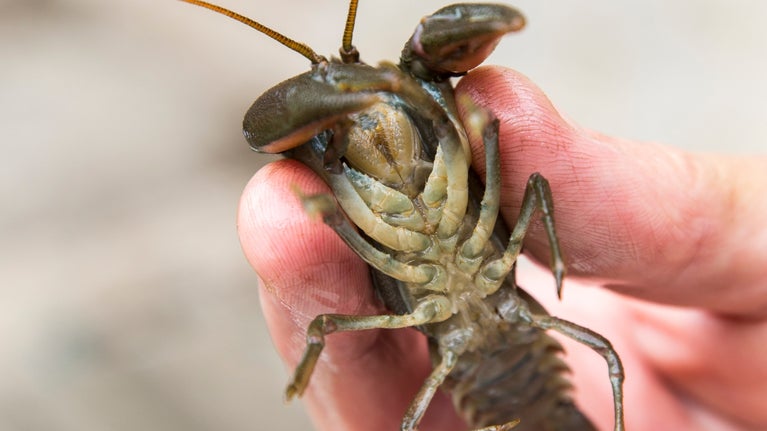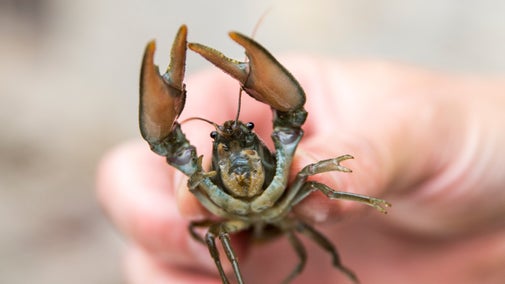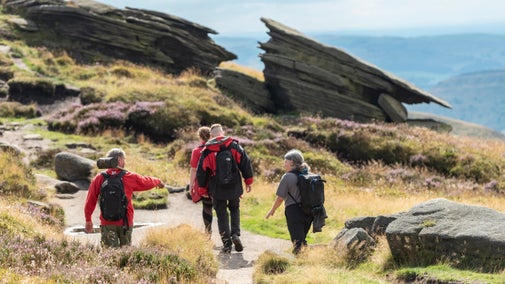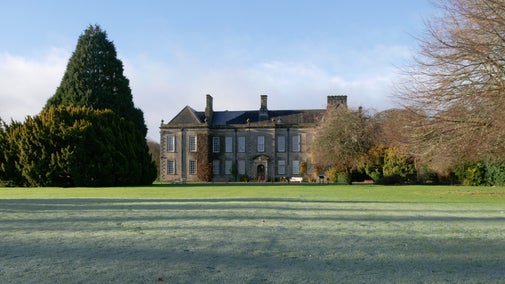Saving the native white-clawed crayfish

Jump to
Wallington is well known for its wildlife, and what makes it so special is the variety of native species that call this beautiful place home. Our countryside team, along with other leading ecological organisations, are working hard to safeguard the future of some of the most critically endangered native species in the country. We’re now undertaking a significant conservation project protecting the native white-clawed crayfish.
What are white-clawed crayfish and why are numbers declining?
The white-clawed crayfish is our only native crayfish and is the largest freshwater invertebrate in the UK. Sadly, their numbers have declined significantly over the last ten years, with a loss of 50-80% across its European range and it is now classified as endangered and at risk of extinction.
Their decline has primarily been caused by the invasion of non-native species the American signal crayfish. Signal crayfish outcompete the white-clawed for homes and food, they carry a disease called ‘crayfish plague’ which is harmless to themselves but lethal to the white-clawed, and they are bigger and stronger than the white-clawed and can eat them. Other contributing factors to their fall in numbers include loss of habitat and pollution in the rivers.
What’s the connection to Wallington?
Wallington is one of the few places in England that continues to have a significant population of white-clawed crayfish, with no invasive species present. Living in the River Wansbeck and its tributaries which meander through the 13,500 acre estate, the white-clawed crayfish are now the focus of a conservation project led by the countryside team at Wallington, looking to safeguard their future on the estate.
We are part of the Northumberland Crayfish Partnership, working alongside other interested conservation bodies such as the Environment Agency, Northumberland Wildlife Trust and the Rivers Trusts to protect this species across the North-East of England.
What’s the conservation plan?
To inform conservation work, it’s important to find out exactly where across the 20 square mile Wallington estate the White Clawed Crayfish are located. As such, the team at Wallington have set artificial refuge ‘traps’ at a number of different locations in the River. These don’t actually trap the Crayfish, they simply provide a home or ‘refuge’ for them from which they can come and go. They are a series of open-ended pipes, attached to a baseplate, which are placed in the river in locations attractive to the Crayfish. They naturally seek refuge under stones and they are attracted to these dark, safe refuge ‘traps’. Left in situ for a period of approximately 3 weeks, the team then recover the traps, lifting each to record what is found within. Each Crayfish is measured and a record is made of its sex, any disease or damage present and stage of moult (the process by which Crayfish shed their hard outer shell).
These surveys are used to identify strategies to protect and enhance the populations of White-clawed Crayfish, through improving our understanding of the threats to populations, agreeing our priorities and taking appropriate actions. We’ll reduce the risk from invasive species and increase existing populations through informed habitat and land management practices.

'Ark' sites
A milestone in the conservation programme was the establishment of an ‘Ark’ site for White-Clawed Crayfish here at Wallington back in 2022, the first in the North East. An ‘Ark’ site is a contained water body that doesn’t currently have any Crayfish living in it but is otherwise a good habitat for them. Because it is contained, it is isolated from the risks of American Signal Crayfish. The Wallington ‘Ark’ site is located in Fountains Plantation, off the green cycle trail. The area was once a drinking point for cattle. The traditional cobbled entry into the water provides refuges for Crayfish in between the stones, and the dry-stone walls on the stream banks help to reduce erosion and also provide safe hiding places.
After applying to Natural England for permission and obtaining a license, we trapped, recorded and moved crayfish from the population living in the river Wansbeck into the ‘Ark’ site, aiming to recreate the same mix of age and gender as is found in the natural population. The first relocation of Crayfish to the ‘Ark’ included Crayfish carrying eggs, know as ‘berried’ females and following further translocations, now comfortably houses a population of around 300 crayfish.
A second 'Ark' site was established in July 2024 on one of Wallington's tenant farms, where a population of 150 White-clawed Crayfish were released.
We’re also working to improve White-Clawed Crayfish habitats across the Wallington estate. By taking measures like fencing water bodies off from livestock, creating designated crossing points and using traditional methods to protect riverbanks water quality will be improved and erosion reduced.
There’s a lot to be done but things are underway.
What can you do to help?
It is very easy to make small changes, which can help protect the White-clawed Crayfish. In the very first instance, you can help limit the transfer of Crayfish plague, which devastates populations of White-clawed Crayfish and is easily transferred between watercourses. In order for you to play your part in the protection of this species, we ask you to follow the CHECK-CLEAN-DRY set of principles if you have been in water.
The cause of Crayfish Plague is a water mould, which attacks the soft tissue of crayfish and has a 100% mortality rate. Were it to get into the upper catchment of a river it would wipe out an entire population within a couple of weeks. You can unwittingly transfer it from one watercourse to another on items such as wellies, clothing and even on your dog! The microscopic spores can survive out of water for 48 hours and if in wet or muddy items it can survive for up to 3 weeks. If accessing our watercourses we would ask that that people follow the Check, Clean, Dry protocol for biosecurity for invasive species. This link will tell you more about what to do www.nonnativespecies.org/checkcleandry/ and you can also watch this video highlighting the steps you can take to help.
Check, Clean, Dry to protect White-clawed crayfish at Wallington
Help protect the endangered native, White-clawed crayfish at Wallington and around the country by following the Check-Clean-Dry protocol when you've been in rivers and watercourses.
Allow video to play? This page contains content that is published to YouTube.
We ask for your permission before anything is loaded, as this content may introduce additional cookies. You may want to read the Google YouTube terms of service and privacy policy before accepting.
The next steps
Whilst we’re busy moving the conservation project forwards, you can keep an eye out for updates on our social media channels and website. The ranger team also host a number of engagement days throughout the year so keep an eye on the website for details.
You might also be interested in
Crayfish Engagement Days
Meet the rangers down on the river walk and find out more about the fascinating native white-clawed crayfish. Friday 15 August and Saturday 6 August, 1-3pm

Wilder Wallington – a landscape for people and nature
Wallington is going big! Wilder Wallington is a landscape-scale nature renewal project across the whole estate and beyond, aiming to capture carbon, reverse the decline in biodiversity and the impacts of climate change, and provide a place where nature and people to thrive together.
Pine marten conservation at Wallington
The pine marten was once a familiar feature of English woodlands and plays an important role in keeping our woodlands healthy and balanced. It's thought that the species was once the country’s second most common carnivore (after the weasel), but due to habitat loss and hunting it's now the second rarest (after the wildcat). Here at Wallington we're working in partnership with Vincent Wildlife Trust to encourage the natural expansion of pine martens into the Wallington Estate.

Beaver reintroduction at Wallington
Wallington has reintroduced beavers to the estate in an effort to renew and restore nature in the hope that they will help create a wildlife-rich wetland landscape. Over a year and a half after their release, find out what changes we have seen in the enclosure.

Red squirrel conservation at Wallington
The long-term recovery of red squirrels remains a top priority for us here at Wallington and is part of a wider nature recovery programme. Our rangers and volunteers work across the entire estate safeguarding and supporting the variety of native species that call this special place home; read about our red squirrel conservation programme.

Adopt a Plot
Nature is depleting faster in the UK than almost anywhere else in the world. Donating to Adopt a Plot is a small way you can take a big step towards restoring nature across landscapes.

Wallington
Discover Wallington, where a historical house meets rolling hills, woodlands and a walled garden.
